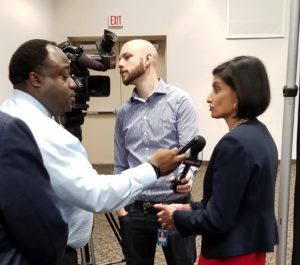“Patients over paper” – Medicare Chief Seema Verma
How does one manage mega-billion government-funded Medicare and Medicaid – two red hot healthcare issues? With about 11,000 mind-numbing pages of “absolutely overwhelming” regulations, according to CMS administrator Seema Verma.

Medicare today serves up healthcare coverage for about 58 million Americans, with total federal expenditures in the $549 billion range. Verma, who previously led successful state healthcare policy under Indiana Governors Mitch Daniels and Mike Pence, doesn’t like much of it at all.
Emerging on deck in a Nov. 3 town hall meeting at the JCC in Indianapolis, Verma said that the message from physicians and healthcare professionals is clear: burdensome Medicare regulations are “getting in the way of providing high quality care.”
Time to Rethink
As the chief administrator of the half a trillion-dollar agency, Verma wants government and healthcare stakeholders to “rethink how we’re paying for this – focus on good outcomes…the big picture.” At the same time government tries to improve federal healthcare service, it also must “make sure that this program is around in the future,” she said.
While Verma left off commenting about recent Trump administration efforts to reform Obamacare and the funding for Medicaid, she had plenty to say about the state of healthcare in America. Federal agencies overseeing healthcare administration must “put patients in the driver’s seat,” she emphasized.
Things Get Personal
A gold-plated resume in healthcare consulting and advancement has made for a successful career for the CMS chief. But things suddenly got very personal recently. Verma experienced firsthand the challenges people face in securing and paying for quality healthcare when her life took a complicated turn.
While recently traveling with their children, Verma’s child psychiatrist husband suffered cardiac arrest and collapsed in an airport. She quickly found that “navigating the healthcare system is very difficult.” As her husband received emergency care and physicians ordered “test after test,” Verma later reflected that “not once did we ever talk about how much is this going to cost?”

Verma’s focus today as Medicare/Medicaid CMS director is to “put patient’s in the driver’s seat.” In providing healthcare coverage, federal and state administrators must put “patients over paper.”
This writer took the opportunity to ask the CMS chief about the future of state-funded healthcare programs like HIP 2.0, which Verma herself had helped mold, shape and launch. She affirmed full support, but added that she and her agency were committed to “support state innovation” in Medicaid programs for indigent populations and people who typically cannot afford healthcare coverage.
Veema noted that HIP (Healthy Indiana Plan) had reduced emergency room costs and had actually “increased patient satisfaction.” A critical point to remember is that Medicaid programs in states often is a “top budget item.” Quality of care and service data remain critical pieces of information. How does a prospective patient know that the hospital they’re considering is a “good” hospital. National healthcare needs to “empower patients with good data,” she said.
Protecting consumers from Medicare fraud, improving good outcomes, maintaining patient safety and “empowering patients…[with] as many choices as possible” are Veema’s top priorities. She noted in the town hall that she recently discussed recent Medicare issues with President Donald Trump, and both agreed at that “patients come first.”
By Michael Snyder, managing principal, MEK Group
